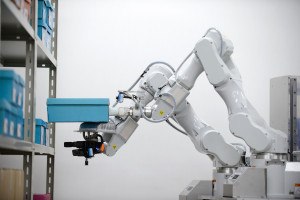In a warehouse in Noda city, east of Tokyo, a robot with wheels zips around to pick up boxes of goods and carries them to a shipping container. It’s Hitachi Ltd.’s vision for the future.
The Japanese maker of bullet trains and power stations recently unveiled a robot that can pick up products ranging from 500-milliliter (17-ounce) plastic bottles to shoe boxes weighing around 1 kilogram (2.2 pounds).

Such robots would have the potential to replace some workers as companies begin turning to them for repetitive tasks such as collecting items from shelves in Amazon.com Inc. warehouses. These new machines would also extend the use of robots from fixed positions on factory floors, a common sight at automakers from Toyota Motor Corp. to General Motors Co.
“We plan to start using them in our own group companies in two to three years and selling them in around five years,” Toshio Moriya, a general manager at Hitachi’s technology innovation center, said in Noda Tuesday. Companies could use tens of robots to more than 100 in a warehouse, he said.
Moriya declined to comment on pricing, except to say it would need to be competitive with current warehouse costs.
The Tokyo-based company is developing the robot’s software system, while Seiko Epson Corp. is making the hardware, according to Hitachi.
Picking up individual objects, while labor-intensive, is a task that remains better performed by humans. It’s a difficult job for robots, which use sensors to identify items that can be confused by packaging. Last year, Amazon hired 80,000 temporary workers for its more than 50 warehouses during the holiday shopping season to do similar tasks.
The number of industrial robots in use has risen to 1.6 million as of 2013 since General Motors first put one on an assembly line in 1961, according to the International Federation of Robotics.





















 Berkshire Hathaway Announces Leadership Appointments: New CEO at GEICO
Berkshire Hathaway Announces Leadership Appointments: New CEO at GEICO  Global Warming Likely to Push Future Hurricane Seasons to Extremes: Study
Global Warming Likely to Push Future Hurricane Seasons to Extremes: Study  The Future of Knowledge in Insurance: From Training to AI-Powered Productivity
The Future of Knowledge in Insurance: From Training to AI-Powered Productivity  Why Insurance Telematics Integrations Fail
Why Insurance Telematics Integrations Fail 








